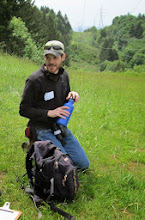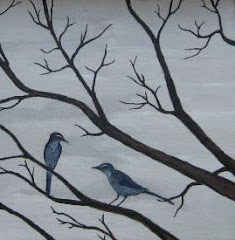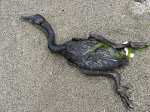
On Friday I made a few trips to Noble Woods Park and observed nesting behavior of many resident birds such as red-breasted nuthatches, bushtits, and American robins.
I spotted my first flycatcher of the year, a treat because they are one of my favorite bird families. It was an Empidonax of some sort and it was too early in the season to confidently identify members of this tough genus, so I simply enjoyed watching it dart from its perch and grab tiny insects with an audible snap of its bill. The bill looked pretty large so, if pressed, I would guess it was a memeber of the "western" or "Trail's" groups.
On Saturday, Sarah went hiking with her friends, so Andie and I took a walk through several local parks.

I brought Andie to a beaver pond built on a tributary of Rock Creek.

This pond is located within a buisiness park that is essentially empty parking lots and office buildings.

I have never seen another soul down here, except for pond-dwelling wildlife. After spending a few minutes near the pond, it is easy to forget that I am in the middle of a rapidly growing commercial area. In fact, a new Whole Foods located a few blocks away will open next week. I prefer the locally owned New Seasons, but I digress.
In Orchard Park, Andie and I checked in on the robin and bushtit nests and I found a bright reddish-orange beetle that my Kauffman insect field guide suggests is a member of the genus Nemognatha, a group whose grubs parasitize bee larva. It had small eyes and large mouthparts that made it look like an ant's head stuck on a beetle's body.

Back home, the Anna's hummingbird nestlings continue to grow. They are now grooming, stretching their wings, and projectile pooping. They should be ready to buzz out of the nest in the next few days.
 I am amazed that these little birds begin nesting in the winter. Perhaps they start early to avoid competition from the more aggressive rufous hummingbirds, or, as a species that recently expanded its range from the south, they are hard-wired to nest early when productivity peaks in southern climates. Whatever the reason, early nesting apparently works for the species.
I am amazed that these little birds begin nesting in the winter. Perhaps they start early to avoid competition from the more aggressive rufous hummingbirds, or, as a species that recently expanded its range from the south, they are hard-wired to nest early when productivity peaks in southern climates. Whatever the reason, early nesting apparently works for the species.







3 comments:
American countryside looks just like the British... but more wondrously prettily temperate (when it is temperate...)... don't you have diamond-back rattlesnakes, black widow spiders/etc out there potentiating the mix, though?
Perhaps an Olive-sided flycatcher? I recall being woken up by one in early spring for a good week straight.
gledwood - rattlesnakes and black widows are mong my favorite western neighbors, but there are not as many here as there are in the eastern part of the state.
JP - I think it was too small to be an olive-sided or a pewee, but I'm not certain. Whatever it was, it was great to see a flycatcher again.
Post a Comment